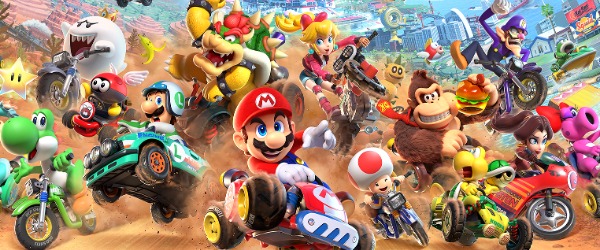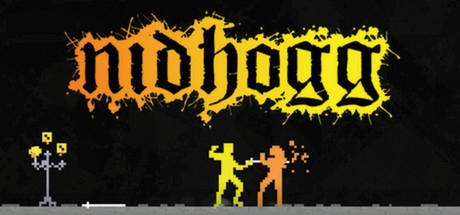
NIDHOGG (PC) - Review
by VGChartz Staff , posted on 17 January 2014 / 4,712 ViewsWhen it was first showcased at different indie events, and eventually at the Independent Games Festival at the Game Developers Conference, NIDHOGG was praised for its exceptionally fluid animations and minimalist feel, winning the IGF Nuovo award in 2011. Now, nearly four years since its initial reveal, NIDHOGG is finally ready to show the rest of the world what it’s made of, storming away from the indie scene and into our hearts with rapiers in hand, one riposte at a time.
If you haven’t heard of or seen NIDHOGG in action, the premise is simple - as an undefined character, you must face off against combatants with your fencing blade while attempting to reach the end of the 2D stage in the direction that your character spawns. Your enemy has the same objective, although needs to reach the end of the level in the opposite direction, and both your character and those you’ll be fighting have infinite respawns to try to stop the other from reaching their goal. Tactical play through both the swordplay and using screen transitioning to your advantage when you're killed or have just killed someone are essential to becoming a good duelist. Killing your enemy near the middle of the screen will give you time to get to the next, while running in the opposite direction when dying will give you a better chance at a counter attack. If you’re successful, you’ll be greeted by a cheering crowd and eaten by the Níðhöggr (Nidhogg), the giant dragon from Norse mythology that gnaws on the World Tree, Yggdrasill, which is the only sense of story that the game offers. Yet NIDHOGG is not intended to be plot oriented. Instead you delve into NIDHOGG’s action, which becomes surprisingly deep.
When you first boot up NIDHOGG I highly suggest going through the tutorial, as it will give you insight into the intricacies of the game. Combat seems rather basic at the beginning, where running, jumping, and attacking are your only movements, all of which can be controlled with either the keyboard or controller, with the controller being a far superior choice for the two button set-up. When unarmed, you can throw some punches, as well as sweep at the opponent's legs or dive kick from the air, both of which can be done when equipped with your trusty rapier. With sword in hand, you can quickly stab or run and lunge at your opponent, with three different positions to hold your sword - head, chest, or knee-to-crotch level.
Knowing where your opponent is holding his rapier is key, as if you attack at the same height, he’ll easily block the attack, especially during the later levels of the single player arcade and against human opponents in multiplayer. Disarming is also possible by moving your sword up or down when you're close enough to the opponent's weapon, as is throwing your weapon across the screen, though this can be blocked as long as your rapier is waist or head level. When every move is combined and utilized, which will be necessary to beat the challenging single player opponents and to have any online success, the action is lightning fast and beautiful to watch unfold. In essence, you can create your own combos, where you fake a lunge, disarm an opponent, jump over him and hurl your sword at the back of his skull in just a few short seconds. It’s simple yet exhilarating action, fuelled by extremely fluid animations and tight controls.
The more intense battles will come in multiplayer, however. The single player arcade mode only requires you to reach the end of the stage in your respective direction, while the multiplayer can be adjusted to have time limits and no goals, just pure, unadulterated fencing matches. As long as you have the most recent kill in single player, you can jump over, run and dodge your opponent to get to the goal to finish the stage. The AI is also rather dodgy, as there were times it would pull off a combo that no human would be able to perform, and others where it would just wait to be killed. In this regard it's a bit easy, though it serves as a great place to fine tune your multiplayer skills, and opens itself up for speed runs galore (my first play through roughly took 38 minutes, and I was able to shave off a good couple minutes on each of my subsequent runs).
Multiplayer can be played both off and online, with multiple different variants that add some interesting parameters, such as no swords, turbo mode, slow mode, not being able to throw your sword or having it return to you like a boomerang when thrown. I had some issues when trying to find a game online, the chat functions are limited and some letters a bit hard to read because of the font choice, trying to invite friends doesn't work quite right all the time, and some connection issues pop up when you're not the host with slight input lag at times, but generally I had a decent online experience. Local multiplayer is always a blast, however, as matches become intense tactical battles where bum rushing an average skilled opponent will lead to nothing but a loss. The variants help to keep matches fresh, but it’s missing one key component - the ability to remove the objective for the match, as timed death matches or infinite battles would be a great addition, though this can be easily agreed upon between the players themselves.
While some might not enjoy NIDHOGG's retro aesthetic style, it is surprisingly beautiful to behold, even with the human shaped and characteristically undefined colors that are the player characters. The game holds an 80s arcade pixelated look, and the minimalist style does wonders for the game's animations, giving life to the fantastic gameplay that would have been much more difficult to pull off with more a detailed look. While there are only four locales (castle, clouds, mines, forest) where duels take place, they are brimming with creativeness, with colors swirling in the background in hypnotic fashion. The cloud level, which is my personal favorite, allows the clouds to help during duels; they can hide your presence or the enemy completely when not in combat or moving too quickly. It can be a bit frustrating after you’ve tossed your sword unsuccessfully and are frantically looking for it, but it adds another level of tactical play, as do the other three levels in their own ways. Music is provided by the very talented Daedelus, and the electronic beats mixed with a gothic, otherworldly feel fuel the intense action magically. When the chiptune gets added in, it’s a perfect fit for NIGDHOGG. The score is superbly crafted, and I’ve been listening to it almost on repeat since the game released.
It was a long time coming, but NIDHOGG doesn’t fail to impress, even after four years of waiting. The issues with online functionality and play do little to mrr the game's incredibly precise and exciting fencing duels. You can snag a copy for $11.99 until January 20th (afterwards it reverts to its normal price of $14.99). Whether you hop on it now or wait a bit, it's well worth the price of admission.
VGChartz Verdict
8.2
Great
This review is based on a digital copy of NIDHOGG for the PC, provided by the publisher.


























 Essay Pro
Essay Pro